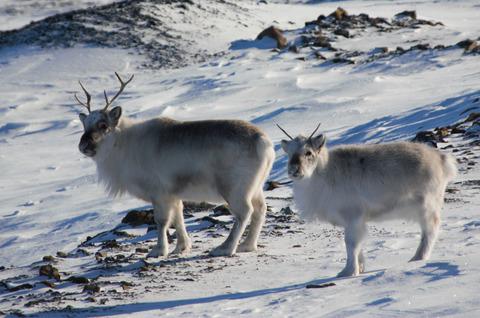当前位置:
X-MOL 学术
›
Funct. Ecol.
›
论文详情
Our official English website, www.x-mol.net, welcomes your
feedback! (Note: you will need to create a separate account there.)
Fat storage influences fasting endurance more than body size in an ungulate
Functional Ecology ( IF 4.6 ) Pub Date : 2021-04-26 , DOI: 10.1111/1365-2435.13816 L. Monica Trondrud 1 , Gabriel Pigeon 1, 2 , Elżbieta Król 3 , Steve Albon 4 , Alina L. Evans 5 , Walter Arnold 6 , Catherine Hambly 3 , R. Justin Irvine 4, 7 , Erik Ropstad 8 , Audun Stien 9 , Vebjørn Veiberg 10 , John R. Speakman 3, 11, 12, 13 , Leif Egil Loe 1
中文翻译:

在有蹄类动物中,脂肪储存对禁食耐力的影响大于对体型的影响
更新日期:2021-04-26
Functional Ecology ( IF 4.6 ) Pub Date : 2021-04-26 , DOI: 10.1111/1365-2435.13816 L. Monica Trondrud 1 , Gabriel Pigeon 1, 2 , Elżbieta Król 3 , Steve Albon 4 , Alina L. Evans 5 , Walter Arnold 6 , Catherine Hambly 3 , R. Justin Irvine 4, 7 , Erik Ropstad 8 , Audun Stien 9 , Vebjørn Veiberg 10 , John R. Speakman 3, 11, 12, 13 , Leif Egil Loe 1
Affiliation

|
- The fasting endurance hypothesis (FEH) predicts strong selection for large body size in mammals living in environments where food supply is interrupted over prolonged periods of time. The Arctic is a highly seasonal and food-restricted environment, but contrary to predictions from the FEH, empirical evidence shows that Arctic mammals are often smaller than their temperate conspecifics. Intraspecific studies integrating physiology and behaviour of different-sized individuals may shed light on this paradox.
- We tested the FEH in free-living Svalbard reindeer Rangifer tarandus platyrhynchus. We measured daily energy expenditure (DEE), subcutaneous body temperature (Tsc) and activity levels during the late winter in 14 adult females with body masses ranging from 46.3 to 57.8 kg. Winter energy expenditure (WEE) and fasting endurance (FE) were modelled dynamically by combining these data with body composition measurements of culled individuals at the onset of winter (14 years, n = 140) and variation in activity level throughout winter (10 years, n = 70).
- Mean DEE was 6.3 ± 0.7 MJ/day. Lean mass, Tsc and activity had significantly positive effects on DEE. Across all 140 individuals, mean FE was 85 ± 17 days (range 48–137 days). In contrast to the predictions of the FEH, the dominant factor affecting FE was initial fat mass, while body mass and FE were not correlated. Furthermore, lean mass and fat mass were not correlated. FE was on average 80% (45 days) longer in fat than lean individuals of the same size. Reducing activity levels by ~16% or Tsc by ~5% increased FE by 7% and 4% respectively.
- Our results fail to support the FEH. Rather, we demonstrate that (a) the size of fat reserves can be independent of lean mass and body size within a species, (b) ecological and environmental variation influence FE via their effects on body composition and (c) physiological and behavioural adjustments can improve FE within individuals. Altogether, our results suggest that there is a selection in Svalbard reindeer to accumulate body fat, rather than to grow structurally large.
中文翻译:

在有蹄类动物中,脂肪储存对禁食耐力的影响大于对体型的影响
- 禁食耐力假说 (FEH) 预测,生活在食物供应长时间中断的环境中的哺乳动物对大体型的选择很强。北极是一个高度季节性和食物限制的环境,但与 FEH 的预测相反,经验证据表明北极哺乳动物通常比它们的温带同类小。整合不同体型个体的生理学和行为的种内研究可能会阐明这一悖论。
- 我们在自由生活的斯瓦尔巴德驯鹿Rangifer tarandus platyrhynchus 中测试了 FEH 。我们测量了 14 名体重在 46.3 至 57.8 公斤之间的成年女性在晚冬期间的每日能量消耗 (DEE)、皮下体温 ( T sc ) 和活动水平。冬季能量消耗 (WEE) 和禁食耐力 (FE) 通过将这些数据与冬季开始时(14 年,n = 140)和整个冬季(10 年,n = 140 n = 70)。
- 平均 DEE 为 6.3 ± 0.7 MJ/天。瘦体重、T sc和活动度对 DEE 有显着的积极影响。在所有 140 个人中,平均 FE 为 85 ± 17 天(范围 48-137 天)。与 FEH 的预测相反,影响 FE 的主要因素是初始脂肪量,而体重和 FE 不相关。此外,瘦体重和脂肪量没有相关性。与相同大小的瘦个体相比,脂肪中的 FE 平均长 80%(45 天)。将活性水平降低约 16% 或T sc降低约 5% 分别使 FE 增加 7% 和 4%。
- 我们的结果无法支持 FEH。相反,我们证明 (a) 脂肪储备的大小可以独立于物种内的瘦体重和体型,(b) 生态和环境变化通过对身体成分的影响影响 FE,以及 (c) 生理和行为调整可以改善个人的 FE。总而言之,我们的结果表明,斯瓦尔巴德驯鹿有一种选择来积累体脂肪,而不是在结构上长得很大。











































 京公网安备 11010802027423号
京公网安备 11010802027423号